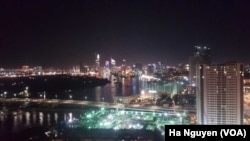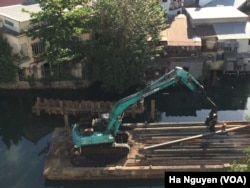Consider that buildings can be designed, in relation to the sun, depending on whether occupants want to maximize the amount of natural light their windows let in, or to minimize the heat absorbed by the building.
Or that they can be built with sensors to detect water leaks, thus reducing the chances that water will be wasted from the start.
More and more architecture students across Vietnam are learning these and other concepts as the country rolls out curriculum on environmentally friendly design. The Southeast Asian nation is still an emerging market, so it has time to build the economy on green standards and to avoid some of the inefficient construction mistakes of older industrialized nations. And as construction is also a major source of greenhouse gas emissions around the world, Vietnam has the chance to adopt a sustainable approach to the industry that could decrease its exposure to the threats of climate change, which is a key concern for the tropical country.
Emphasis on Green education
“Although there have been several seminars and workshops, there are no well-rounded courses on green building for students in Vietnam,” said Nguyen Cong Thinh, who is the vice director of the science, technology, and environment department at the Vietnamese Ministry of Construction.
But in February his office started working with the Swiss government and the World Bank’s lending agency the International Finance Corporation, bringing exactly these kinds of courses to college campuses. They began with what they call a “training of the trainers,” who learn resource efficiency principles that they can then go on to teach the next generation of builders in Vietnam.
“We are delighted to introduce this course to future architects and engineers in an internationally recognized format that offers a global perspective and a local context,” Thinh said.
For example the participants study ways that structures can be planned to save electricity and water, as well as to be “bioclimatic,” which means that they adapt to the surrounding environment. In the northern capital of Hanoi, it is more useful to firm up insulation and conserve heat to keep people warm in the winter. But in contrast in the southern metropolis of Ho Chi Minh City there are just two seasons -- rainy and dry -- and not much need to heat buildings. Instead designers can consider how to position southern buildings to take advantage of wind tunnels, which bring natural ventilation in the humid climate, or to soak up sun rays to generate the most solar power possible.
Environmentally vulnerable
Vietnam counts itself among the top five countries in the world that would be devastated if global warming gets even more severe, especially with its 3,000 kilometers of coast along the South China Sea. As it works to implement an action plan under the Paris Climate Change Accord, the country is looking for ways to mitigate the environmental toll of the fast-growing construction industry, which consumes a lot of sand for cement, electricity, and other building supplies. The construction and industrial sectors expanded 8.8 percent in 2018 versus the year earlier, higher than the overall economy’s expansion of 7 percent, according to data from the property developer Jones Lang Lasalle Vietnam.
Other methods that students are learning to increase design efficiency include use of modeling software, so they can experiment with different eco-friendly technologies before any physical construction begins. They are also studying building codes and standards, as well as the types of construction materials that do the least harm to the environment.
“In recent times, we have integrated green building into the curriculum of nearly all faculties. However, this course will further help students to become familiar with green building modeling software and present ideas clearly and quantitatively to future clients,” said Dr. Le Van Thuong, who is the rector of the University of Architecture in Ho Chi Minh City.
There are other ideas to improve efficiency whether at the office, the factory, or the home. Increasingly people are installing dual flush toilets, which allow users to choose how much water is dispensed at a time, and shower systems that warm up water before it is released, so they don’t have to let water go to waste as it heats up. And you don’t have to be an architect to add these technologies to a building.








